|
|
|||
|
(Back to Preceding Week; on to Next Week) |
|
Join Us for the |
|
|
50,000 . . . AND COUNTING:
WHY WE BAND BIRDS We well remember back to a time during the last century--as late as January 1976 to be exact--when we thought watching birds was a dumb way to spend one's time. We enjoyed nature, but our preferences were to catch snakes and take photos of wildflowers. We couldn't figure why one would get up before dawn, dangle heavy binoculars around one's neck, and spend endless hours straining one's eyes to look at elusive feathered creatures in treetops. Then, in February '76, a boisterous Carolina Wren (below left) came to our sickbed window and sang us back to health, followed shortly thereafter by oft-mentioned old friend Jim Shuman's field instruction on how to watch birds,
All text & photos © Hilton Pond Center Even before we came back south we put down earnest money on what is now Hilton Pond Center for Piedmont Natural History and in March 1982 erected several bird feeders around the old farmhouse that today serves as home and office. We closed the deal on the Hilton Pond property, returned from Minnesota that summer, and on 30 June 1982 banded our first local bird--an adult male Red-winged Blackbird. Since then quite a few other birds have passed across the Center's banding table; in fact, this week on 7 December 2007 we trapped and released the raspberry colored male House Finch pictured above, an individual worthy of note because he became the 50,000th bird banded during our 26 years of research at Hilton Pond Center!
It's appropriate bird #50,000 was a House Finch because through this week at Hilton Pond Center we've handled 7,598 of them--more HOFI than any of our 123 other species; altogether, House Finches make up 15.2% of our 26-year total. Close behind are 7,169 Purple Finches (14.3%) and 6,703 American Goldfinches (13.5%, winter male above). These three species--plus Pine Siskins (1,544 for 3.1%)--comprise 46.1% of birds captured at Hilton Pond, primarily because the four "winter finches" assemble in good numbers at feeders and All these numbers are interesting, but bird banding is NOT a game in which we try to see how many birds we can capture. Numbers ARE important, however, because they reflect the depth and breadth of our banding endeavors at Hilton Pond. Our 50,000 banded birds make the Center one of the most active ornithological study sites in the Southeast, and our 26 years of near-continuous work means the Center is also something all-too-rare in the scientific world--a truly long-term study site with potential to document change over time. It's for these reasons Hilton Pond Center has been designated an Important Bird Area by the National Audubon Society and BirdLife International. So what is the real function of bird banding, i.e., why DO we band birds? Aside from the educational value mentioned above, we see lots of good reasons for banding programs--all of which provide information scientists can't effectively gather in any other way. Banding is conducted under the jurisdiction of the federal Bird Banding Laboratory (BBL), formerly a unit of the U.S. Fish & Wildlife Service and now part of the U.S. Geological Survey. The BBL and CWS authorize trained personnel to capture and band wild birds for research and educational purposes. Master Banders include, among others, employees at federal and state agencies, university researchers, bird observatory staff members, and private individuals. Most banders are also required to have state banding permits issued through their respective state governments. There are currently only about 3,000 Master banding permits in the U.S. and Canada, plus about that many subpermittees. Hummingbird banding requires special training and additional authorization, which is why less than 200 people in the U.S. and Canada are actively involved in capturing and banding these tiny birds. Bird banding is one of the most useful tools in ornithology, but its success depends on willingness by the public--and other banders--to report banding encounters. Data from recovered bands do indeed provide otherwise unattainable information. For more than 50 years, for example, birders have sat on North Lookout at Hawk Mountain Sanctuary in Pennsylvania (below right) to watch majestic raptors glide past in fall migration. If you were to judge our banding success at Hilton Pond Center solely on how many of our banded birds have been found elsewhere, you might say we haven't done so well--although we have a ton of valuable recapture records for year-round residents and returning migrants. Of our 50,000 banded birds, only 52 have been encountered outside York County SC--a rate of only about 0.1%. Another 26 (0.05%) were encountered within our home county. But even those small percentages have revealed things science did not know about birds that originate in or migrate to or through the Carolina Piedmont.
For example, prior to 1991 NONE of the 150,000 or so Ruby-throated Hummingbirds banded (above) in the U.S. and Canada by all banders had ever been encountered more than 10 miles away from the banding site. Although field ornithologists understood from direct observation that nearly all our North American RTHU end up in Mexico or Central America during the non-breeding months, no one knew for sure about actual migratory pathways or whether RTHU from, say here in South Carolina, all migrated to a particular locale in the tropics.
Science got its first specific data about long-distance RTHU movements when a young male banded at Hilton Pond on 16 September 1991 was retrapped ten days later at Loganville GA, a suburb of Atlanta; this was the first-ever 10-mile-plus "foreign encounter" for a RTHU (see map above). Since then we've had one RTHU retrapped at Robertsdale AL (near Mobile), another found dead in central Alabama at Thomaston, and a fourth with the Center's unique green color mark on its breast observed at Cameron in southwestern Louisiana. All these fall migrant birds left Hilton Pond and migrated in a southwesterly direction, dispelling a commonly held belief that East Coast RTHU migrate to Florida in autumn before crossing the Gulf of Mexico.
Migration and site fidelity are certainly things we could not understand without banding, nor could we know for sure the age of individual birds. When you look out the window at a White-throated Sparrow (WTSP) at your feeder, it looks pretty much like all the other white-throats in the vicinity--and like the ones that were there last year or the year before. When we band a WTSP (above and below right) at Hilton Pond and recapture it in later years we conclusively learn about its expected life span--something that's important in understanding the species and its survival rates. Incidentally, the longevity record for White-throated Sparrows, according to the BBL, is 9 years 8 months--more than one might expect; And speaking of White-throated Sparrows, back on 15 April 1990 we caught one in a ground trap outside our office window. We banded the bird and released it, thinking mid-April was high time for a white-throat to be moving toward its breeding grounds. And move north it did. In fact, this speedy little bird went at a fast clip, covering at least 970 straight-line miles in just two weeks. And how do we know this? Well, on 1 May 1990 this particular WTSP was found dead at Lake à la Ligne in Quebec, Canada--right after it was killed by a free-roaming cat! Undoubtedly exhausted from its lengthy northward journey, our long-distance white-throat was easy prey for a non-native predator that had no business being in position to kill a migratory native songbird. This particular White-throated Sparrow not only told us something of interest about distance and speed of migration but also something about an avoidable environmental factor that can lead to a bird's demise.
One other major aspect of the behavioral ecology of birds that we would not fully understand without banding efforts is what we call "population dynamics." For example, after banding Northern Cardinals (male above) at Hilton Pond since 1982, we know to expect an average of 79 "redbirds" in a calendar year; with 117 on the books so far in 2007, we are well above the mean.
However, if we look at a detailed chart (above) of all 26 years of banding cardinals at Hilton Pond, we see this year's total of 117 is more significant than one might think--it's nearly twice the average of 63.5 NOCA we've banded during the previous seven years. (Perhaps cardinals had particularly good breeding success this year.) The chart also reveals other curious information, especially that the number of cardinals banded annually at Hilton Pond Center during the current decade is significantly lower than in the early and middle 1990s. Whenever such variation is revealed by banding data it gives ornithologists reason to seek possible causes. Assuming we put forth about as much banding effort year-to-year--and we do--it is logical to first look at environmental changes that might have impacted the local NOCA population. We can document at least two such variables that could have affected the dynamics of local NOCA populations.
A second environmental factor that may have affected our cardinal population came when more than 60 acres of pine woods adjoining Hilton Pond Center were removed in 1996. Although the pine habitat might not have been important for NOCA nesting, it's likely dense evergreen boughs provided winter shelter that allowed adult cardinals to survive from year to year. Interestingly, after the 1996 clear-cut we saw reduction in several other bird species, including Blue Jays, House Finches, Purple Finches, Brown-headed Nuthatches, and Pine Warblers (below)--all birds known to frequent piney woods.
Other environmental factors might have led to a reduction of Northern Cardinals at Hilton Pond starting around 2000, including the appearance of West Nile Virus. We also were in the middle of a five-year drought at that time. It may be that a combination of all the factors mentioned above led to fewer NOCA. And perhaps the significant increase in cardinal numbers in 2007--another drought year--has occurred because NOCA from surrounding areas have been drawn to whatever water remains in Hilton Pond. We may never understand all the dynamics that lead to changes in bird populations, but by banding we at least know there ARE such changes and are thus stimulated to see what environmental factors might be suspect.
At Hilton Pond Center there are lots of reasons why we band birds, including the honor of being able to photograph the adult male Eastern Bluebird above. In addition to the public education benefits of a banding program, we also learn much about birds that isn't knowable from mere observation through binoculars or a spotting scope--be it the specifics of migration, site fidelity, longevity, or population dynamics. Banding birds will always be an integral part of our research, education, and conservation efforts at the Center. And even though our "This Week at Hilton Pond" photo essays cover a wide variety of nature topics, we append every installment with a tally of birds caught or recaptured during that week--all in the effort to share what we learn about birds through banding. We're happy to announce our 50,000th banded bird this week and look forward to reporting new numbers and population changes in future weeks and years. We just hope our local and global environment continues to support the grand diversity of birds we're fortunate to observe--and band--at Hilton Pond Center.
All text & photos © Hilton Pond Center POSTSCRIPT: For more information about Hilton Pond Center's bird banding program, with results, please see the pages linked from Banding Charts & Tables.
Comments or questions about this week's installment?
Thanks to the following fine folks for recent gifts in support of Hilton Pond Center for Piedmont Natural History and/or Operation RubyThroat: The Hummingbird Project. Your tax-deductible contributions allow us to continue writing, photographing, and sharing "This Week at Hilton Pond." (Please see Support if you'd like to make a gift of your own.)
IMPORTANT NOTE: If you ever shop on-line, you may be interested in becoming a member of iGive, through which nearly 700 on-line stores from Barnes & Noble to Lands' End will donate a percentage of your purchase price in support of Hilton Pond Center and Operation RubyThroat. For every new member who signs up and makes an on-line purchase iGive will donate an ADDITIONAL $5 to the Center. Please sign up by going to the iGive Web site; as of this week, 197 members have signed up to help Hilton Pond Center. It's a painless, important way for YOU to support our work in conservation, education, and research. "This Week at Hilton Pond" is written & photographed You may wish to consult our Index of all nature topics covered since February 2000. You can also use our on-line Hilton Pond Search Engine at the bottom of this page. For a free, non-fattening, on-line subscription to |
|
Make direct donations on-line through
Network for Good: |
|
|
LIKE TO SHOP ON-LINE?
Donate a portion of your purchase price from 700+ top on-line stores via iGive: |
|
|
Use your PayPal account
to make direct donations: |
|
| The highly coveted Operation RubyThroat T-shirt --four-color silk-screened--is made of top-quality 100% white cotton--highlights the Operation RubyThroat logo on the front and the project's Web address (www.rubythroat.org) across the back.
Now you can wear this unique shirt AND help support Operation RubyThroat: The Hummingbird Project and Hilton Pond Center. Be sure to let us know your mailing address and adult shirt size: Small (suitable for children), Medium, Large, X-Large, or XX-Large. These shirts don't shrink! Price ($21.50) includes U.S. shipping. A major gift of $1,000 gets you two Special Edition T-shirts with "Major Donor" on the sleeve. |
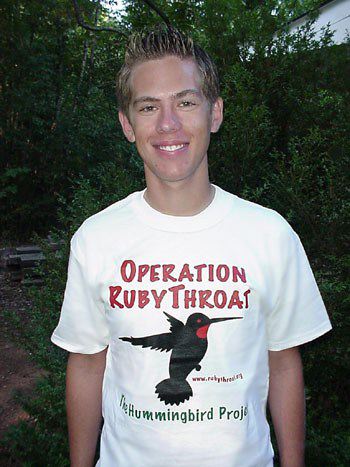
Need a Special Gift just in time for the Holidays? (Or maybe you'd like to make a tax-deductible donation during 2007) If so, why not use our new handy-dandy on-line Google Checkout below to place your secure credit card order or become a Major Donor today? |
|
|
|
|
SPECIES BANDED THIS WEEK: * = New species for 2007 WEEKLY BANDING TOTAL 9 species 128 individuals YEARLY BANDING TOTAL (2007) 65 species 1,921 individuals 26-YEAR BANDING GRAND TOTAL (since 28 June 1982) 124 species 50,004 individuals NOTABLE RECAPTURES THIS WEEK (with original banding date, sex, and current age) Carolina Chickadee (3) American Goldfinch (4) Dark-eyed Junco (1) Northern Cardinal (4) Eastern Towhee (1) Purple Finch (1) White-throated Sparrow (4) Carolina Wren (1) Tufted Titmouse (1)
|
OTHER NATURE NOTES OF INTEREST --A tally of 128 birds captured made this the most productive banding week of the year at Hilton Pond Center. (Totals slightly exceeded our 126 bandings for 15-21 Nov.) Numbers were boosted by the arrival of what are probably migrant House Finches, plus a continuing record influx of American Goldfinches. --Four Fox Sparrows banded this week brought the annual total to eight, easily surpassing our old record of five set in 1990. As noted previously, this is not a common sparrow at the Center, with only 40 banded since 1982. --One again this week it did not rain on Hilton Pond. The five-month drought continues, and the pond level drops a few inches lower. --The 17th annual York/Rock Hill SC Christmas Bird Count will be compiled by Hilton Pond Center on 22 Dec 2007. As always, we're looking for volunteers who'd like to help census local birds on that day. No experience necessary--just binoculars and a field guide. Homebound folks within the count circle can contribute. Click on the link above for details.
|
|
|
|
(Back to Preceding Week; on to Next Week) Up to Top of Page Back to This Week at Hilton Pond Center Current Weather Conditions at Hilton Pond Center |
 You can also post questions for The Piedmont Naturalist |
Join the |
Search Engine for |
|
|
Yahoo Personals Singles

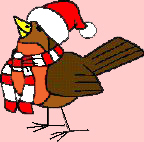
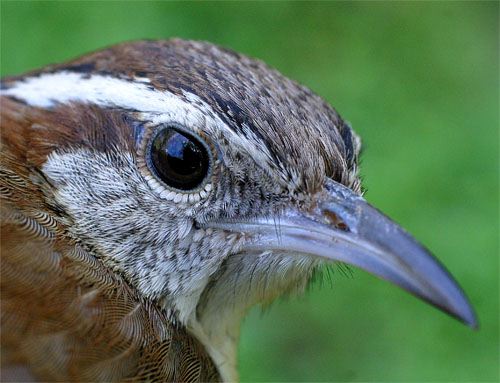 which soon led to our taking a lecture/lab/field class in ornithology in the summer of 1977 under Dr. David W. Johnston at Mountain Lake Biological Station, in the Virginia highlands. During this immersion course Dr. J introduced us to many avian wonders--especially how to run mist nets and band birds--and we were changed forever. We immediately understood how much could be learned from capturing a wild bird and examining it in-hand, but more important was that we also quickly realized what an exciting teaching tool bird banding could be. The very next year we uprooted the family and went off to the University of Minnesota, spending four years banding and color marking more than 1,500 Blue Jays. We wanted to learn about the behavioral ecology of jays, of course, but we mostly sought to perfect our ornithological skills so we could return to South Carolina to share the excitement of banding with a new crop of high school biology students--which eventually we did.
which soon led to our taking a lecture/lab/field class in ornithology in the summer of 1977 under Dr. David W. Johnston at Mountain Lake Biological Station, in the Virginia highlands. During this immersion course Dr. J introduced us to many avian wonders--especially how to run mist nets and band birds--and we were changed forever. We immediately understood how much could be learned from capturing a wild bird and examining it in-hand, but more important was that we also quickly realized what an exciting teaching tool bird banding could be. The very next year we uprooted the family and went off to the University of Minnesota, spending four years banding and color marking more than 1,500 Blue Jays. We wanted to learn about the behavioral ecology of jays, of course, but we mostly sought to perfect our ornithological skills so we could return to South Carolina to share the excitement of banding with a new crop of high school biology students--which eventually we did.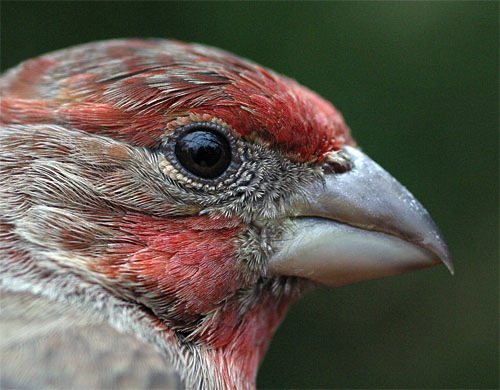
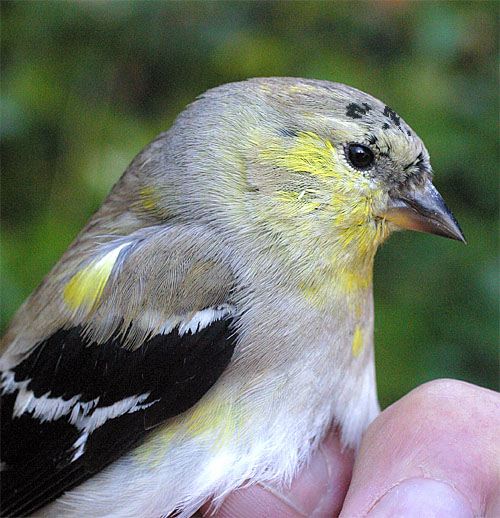
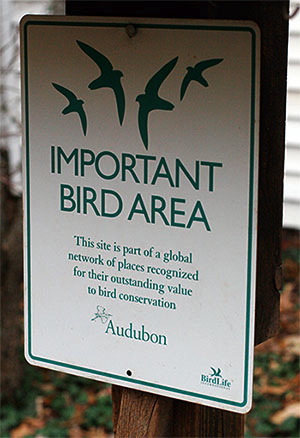 are rather easily caught in traps baited with black sunflower seed.
are rather easily caught in traps baited with black sunflower seed.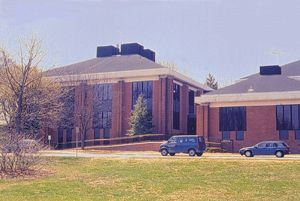 The BBL (below left), headquartered in Laurel MD, is also the permanent repository for data collected during bird banding activities in the U.S. It collaborates closely with the Canadian Wildlife Service (CWS), which coordinates banding activities for Canada.
The BBL (below left), headquartered in Laurel MD, is also the permanent repository for data collected during bird banding activities in the U.S. It collaborates closely with the Canadian Wildlife Service (CWS), which coordinates banding activities for Canada. In North America, birds are captured and marked with appropriately sized and numbered aluminum bands (right) by licensed banders who report to the BBL or CWS. The bander collects data about the bird's age, sex, condition, and plumage characteristics, and may make any number of measurements, especially the wing chord (length of the flattened wing from wrist to tip of the longest primary feather), tail length, mass, and bill length. After the bird is banded and released, the bander files data with the BBL, including precise information about date and location of capture. If someone encounters the bird at a later date, the band number can be reported toll-free at 1-800-327-BAND or through the
In North America, birds are captured and marked with appropriately sized and numbered aluminum bands (right) by licensed banders who report to the BBL or CWS. The bander collects data about the bird's age, sex, condition, and plumage characteristics, and may make any number of measurements, especially the wing chord (length of the flattened wing from wrist to tip of the longest primary feather), tail length, mass, and bill length. After the bird is banded and released, the bander files data with the BBL, including precise information about date and location of capture. If someone encounters the bird at a later date, the band number can be reported toll-free at 1-800-327-BAND or through the  The BBL then contacts the bander and describes when and where the banded bird was encountered and by whom, and the finder gets a Certificate of Appreciation and information about where and when the bird was banded. We received the certificate above for a Gray Catbird encountered in eastern Pennsylvania 12 YEARS after it was banded near Tallahassee FL--845 miles to the south! Frequently the finder and bander correspond or talk by phone to exchange other anecdotal information that may be of value.
The BBL then contacts the bander and describes when and where the banded bird was encountered and by whom, and the finder gets a Certificate of Appreciation and information about where and when the bird was banded. We received the certificate above for a Gray Catbird encountered in eastern Pennsylvania 12 YEARS after it was banded near Tallahassee FL--845 miles to the south! Frequently the finder and bander correspond or talk by phone to exchange other anecdotal information that may be of value.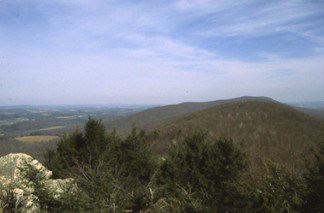 Counting those birds tells us something about hawks--such as whether their numbers are generally increasing or decreasing--but without a banding program at Hawk Mountain biologists could only speculate on where those birds have been, where they're going, or how long they've lived. Through banding, we broaden our knowledge about distribution and movements of many bird species, their relative numbers, annual production, survivability of offspring, life spans, and causes of death. Such information helps us manage and conserve birds wisely at a time when they suffer greatly from habitat loss, pesticides, and a variety of unnatural hazards.
Counting those birds tells us something about hawks--such as whether their numbers are generally increasing or decreasing--but without a banding program at Hawk Mountain biologists could only speculate on where those birds have been, where they're going, or how long they've lived. Through banding, we broaden our knowledge about distribution and movements of many bird species, their relative numbers, annual production, survivability of offspring, life spans, and causes of death. Such information helps us manage and conserve birds wisely at a time when they suffer greatly from habitat loss, pesticides, and a variety of unnatural hazards.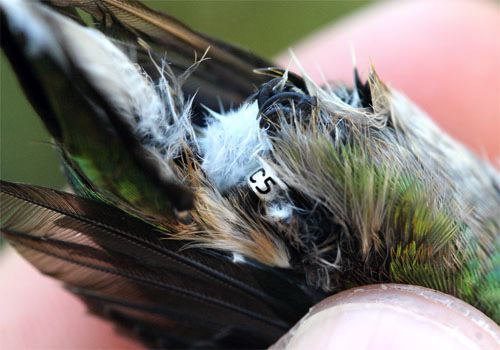
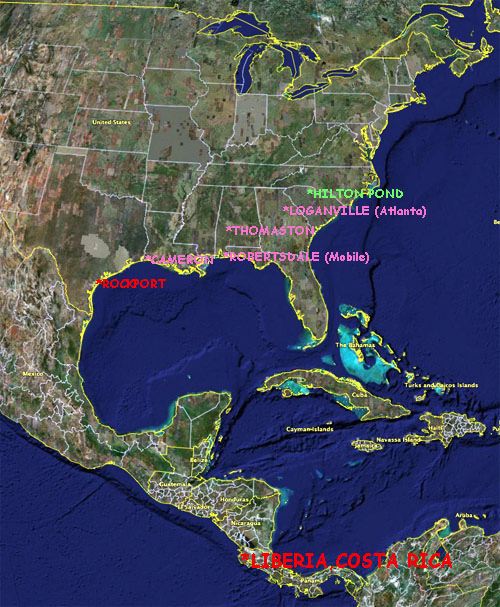
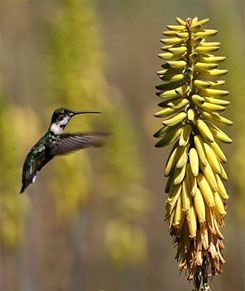 Although there's still never been a banded RTHU encountered south of the Rio Grande River--that's one of the goals of our annual hummingbird expeditions to the area around Liberia, Costa Rica--our four birds from Hilton Pond confirm that RTHU move across the southeastern states in fall and probably toward the vicinity of Rockport TX, where there are huge assemblages of RTHU in September. With this information in hand, science now understands more about RTHU fall migration, which--in turn--shows us we need to protect habitat along a southwesterly route if we are to be sure RTHU have sustenance and shelter throughout the migratory path. Furthermore, after we banded a male RTHU on our Costa Rica study site (above left) and recaptured it in the same Aloe Vera field a year later, science now knows for the first time that RTHU show site fidelity in the tropics just as they do on breeding grounds in North America--ample reason to protect habitat on BOTH ends of the migratory path.
Although there's still never been a banded RTHU encountered south of the Rio Grande River--that's one of the goals of our annual hummingbird expeditions to the area around Liberia, Costa Rica--our four birds from Hilton Pond confirm that RTHU move across the southeastern states in fall and probably toward the vicinity of Rockport TX, where there are huge assemblages of RTHU in September. With this information in hand, science now understands more about RTHU fall migration, which--in turn--shows us we need to protect habitat along a southwesterly route if we are to be sure RTHU have sustenance and shelter throughout the migratory path. Furthermore, after we banded a male RTHU on our Costa Rica study site (above left) and recaptured it in the same Aloe Vera field a year later, science now knows for the first time that RTHU show site fidelity in the tropics just as they do on breeding grounds in North America--ample reason to protect habitat on BOTH ends of the migratory path.
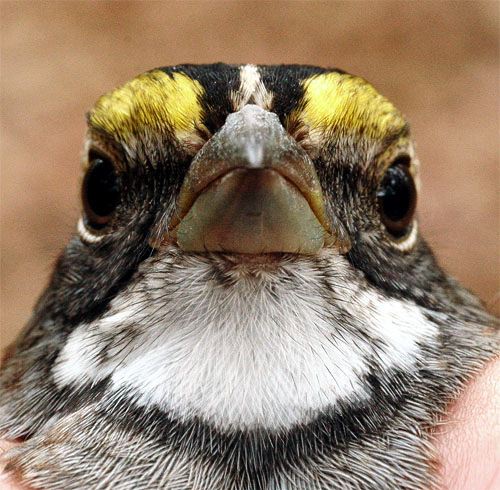 our oldest WTSP at Hilton Pond Center is an after-7th-year bird banded in December 2000 and recaptured just last month.
our oldest WTSP at Hilton Pond Center is an after-7th-year bird banded in December 2000 and recaptured just last month.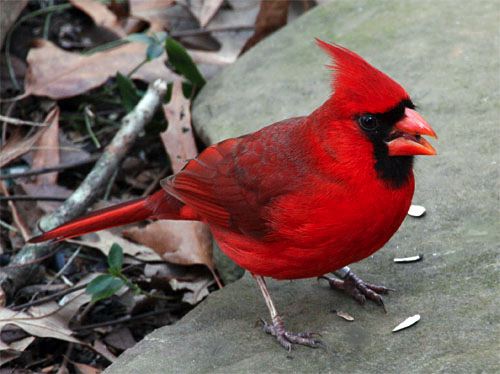
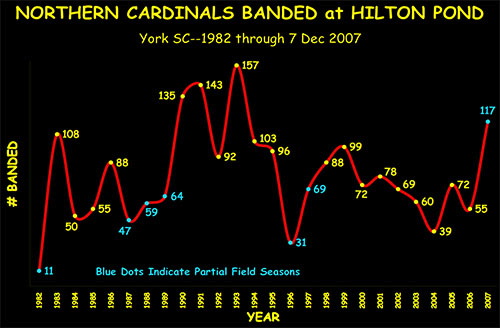
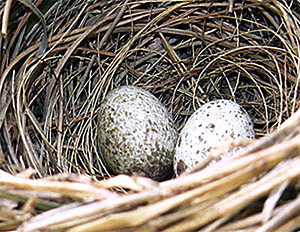 First, the Center was mostly open grassland when we started banding in 1982, but we allowed the property to go through natural succession that led to it being dominated with shrubs and small Eastern Red Cedars by the 1990s. Northern Cardinals prefer to lay their speckled eggs (right) in nests within thickety areas and young woodlands, so it's likely our shrub/cedar habitat allowed higher nesting density and more offspring. As succession continued, however, the Center's shrub layer essentially disappeared and the cedars got shaded out by a canopy mix of hardwoods and pines that seem less attractive to NOCA--hence their reduced numbers in recent years.
First, the Center was mostly open grassland when we started banding in 1982, but we allowed the property to go through natural succession that led to it being dominated with shrubs and small Eastern Red Cedars by the 1990s. Northern Cardinals prefer to lay their speckled eggs (right) in nests within thickety areas and young woodlands, so it's likely our shrub/cedar habitat allowed higher nesting density and more offspring. As succession continued, however, the Center's shrub layer essentially disappeared and the cedars got shaded out by a canopy mix of hardwoods and pines that seem less attractive to NOCA--hence their reduced numbers in recent years.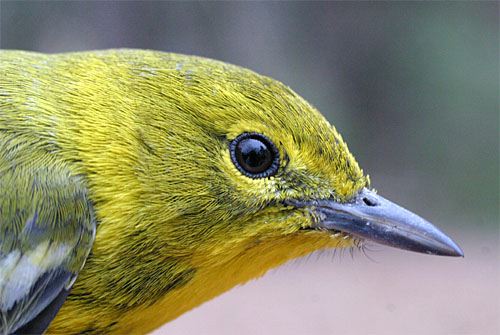
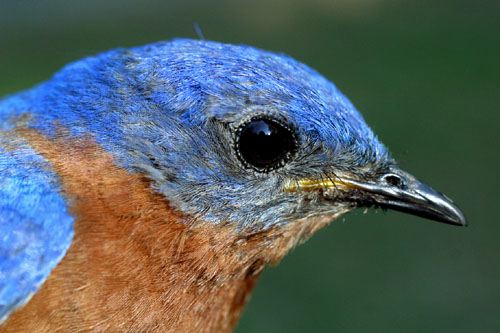


 Oct 15 to Mar 15:
Oct 15 to Mar 15: